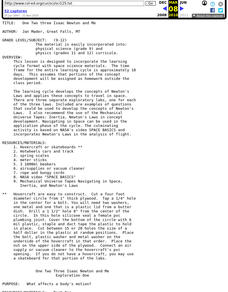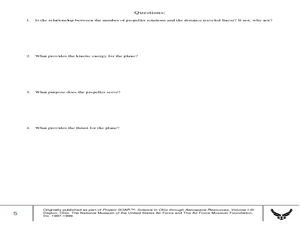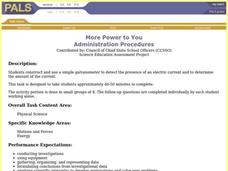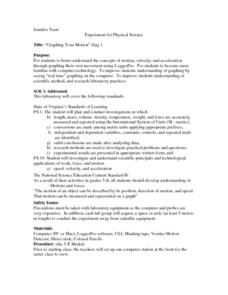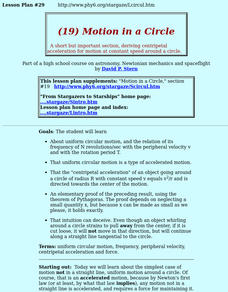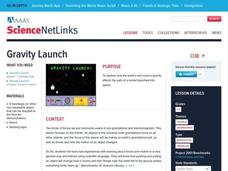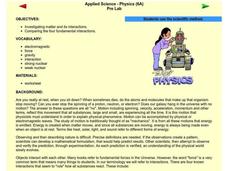Curated OER
Friction
Students explore the force of friction between materials. In this physics lesson, students participate in an experiment using various materials such as wood, waxed paper, and aluminum foil and explore which item produced the most friction.
Curated OER
Challenger's Lost Lessons - The Lost Simple Machines Lesson
Students investigate the characteristics of simple machines. In this simple machine instructional activity, students investigate work as a product of applying constant force. They answer questions about what happens on Earth and what may...
Curated OER
Swingers
Students investigate the motion of a swinging pendulum. They experiment with a pendulum to find out why it might swing at different speeds at different times.
Alabama Learning Exchange
Investigating Friction
Young learners explore friction. They view a video or DVD (bibliography provided) and define terms related to friction, and work in groups to experiment with the effects of friction on speed and motion using ramps and toy cars.
Curated OER
Parachutes: What a Drag
Sixth graders make 2 different kinds of parachutes and record and graph the time for each one for the different drag forces. In this parachute lesson plan, 6th graders compare the results to the rest of the class of each parachute and...
Virginia Department of Education
The Particle Theory of Matter
Demonstrate the particle theory of matter to high school scientists with an engaging experiment that allows them to visually see the results as substances change from one state to another. The class concludes with a discussion about how...
Curated OER
One, Two, Three--Isaac Newton and Me
High schoolers experiment to develop understanding of Newton's Laws and how they apply to space travel in this ten day instructional activity sequence.
Curated OER
Extreme Acceleration
Young scholars explore the concept of acceleration. They determine the acceleration rate of a roller-blader and graph the results.
Curated OER
Changing Ramp Heights
Students conduct an experiment to determine how the change in ramp height affects the distances a ball is able to move a stationary cup. Data is collected from several trials and recorded and analyzed.
Curated OER
Propellers, Forces and Energy
Students construct a model airplane, measure distance, and calculate velocity. For this creative lesson students work in groups to build a model and use it to calculate distances and velocity.
Curated OER
More Power to You
Students construct a simple galvanometer in order to detect the presence of an electric current as well as determine the amount of the current. Activity is divided into two parts, first part as group work and second as individual.
Curated OER
Calibrating a Roverbot
Learners build and program a Lego Mindstorms Roverbot to travel for a given amount of time. They gather data on time versus distance traveled to determine a calibration constant for their robot, which relates time to distance.
Curated OER
Graphing Your Motion-Day 1
Ninth graders explore the concepts of motion, velocity and acceleration through graphing their own movement using LoggerPro. They become more familiar with the computer technology. Students explore graphing in real time and graph on...
Curated OER
Simple Harmonic Motion
Students explain the theory of simple harmonic motion (SHM) by performing hands-on, practical application experiments.
Curated OER
Motion in a Circle
Students explore uniform circular motion, and the relation of its frequency of N revolutions/sec with the peripheral velocity v and with the rotation period T. They examine how uniform circular motion is a type of accelerated motion.
Curated OER
Motion in a Circle
Students study about deriving centripetal acceleration for motion at constant speed around a circle.
Curated OER
Marvelous Magnets
Students identify and classify magnetic and nonmagnetic materials and metals. After determining which materials and metals are magnetic, students create a data table and classify items by two different criteria. Students e-mail various...
Curated OER
Accelerated Frames of Reference: Inertial Forces
Students examine how when applying the laws of motion to an object in an accelerating frame, using coordinates defined in such frame, one must always add an "inertial force", representing forces caused by the frame's acceleration.
Curated OER
Pendulum Motion Experiments
Students experiment with simple pendulums to determine the validity of an equation for all angles. Students discover the usefulnes and limitations of approximations in science. Using spreadhseets and a java applet, students observe the...
Virginia Department of Education
States and Forms of Energy
Energy is just energy, right? Explain various forms of energy to your young scientists by using an interactive experiment that contains common objects to demonstrate complex concepts. Pupils conduct experiments for radiant, thermal,...
Virginia Department of Education
Sound
Add a little music to your next physics class. Pupils discuss how frequency determines pitch and take part in several activities designed to teach them more about sound, melody, resonance, and vibrations. They use materials to construct...
Curated OER
Gravity Launch
Students examine how gravity affects launching rockets into space. In this physical science lesson, students review the concept of gravity and use an interactive online site, "Gravity Launch," to simulate a rocket launch.
Curated OER
Matter and Energy
Students explore energy by completing a science worksheet in class. For this principles of matter lesson, students define the vocabulary terms force, gravity, nuclear, and electromagnetic before reading assigned text about energy....
Curated OER
Vectors
Students describe motion by the use of adding vectors to obtain the resultant vector. They comprehend the meaning of a resultant vector. Students identify the difference between the x and y components of vector quantities. Students...






